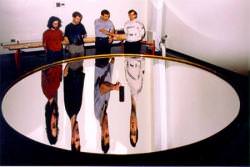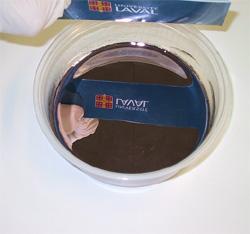Some astronomers feel that rotating liquid mirror telescopes (LMT) may revolutionize astronomy. LMTs work because the basic laws of nature — gravity and centrifugal force — conspire together to give LMTs the perfect, parabolic shape needed for astronomical observing. And unlike ordinary telescopes with glass mirrors that are expensive to make and maintain, LMTs are quite cost effective because of low construction costs (current estimates have liquid mirrors at 1% the cost of a glass mirror) and they don’t need to be polished or housed in an expensive mount.
Ermanno Borra from Canada is one of the foremost experts on LMTs, and he has been constructing and testing different types of these telescopes since the early 1980’s. His latest research involves creating a tiltable LMT — previously thought to be almost impossible — by using a thin, reflective layer of self-assembling metallic nanoparticles.
LMTs are made by spinning a reflective liquid, usually mercury, on a bowl-shaped platform to form a parabolic surface, perfect for astronomical optics. A handful of LMTs are being used today, including a 6-meter LMT in Vancouver, Canada, and a 3-meter version that NASA uses for its Orbital Debris Observatory in New Mexico.
Borra and his colleagues have been experimenting by using different liquids to create LMTs, since part of their research has been geared toward studying the feasibility of constructing a large LMT on the Moon, and mercury freezes at temperatures found at the lunar poles. Since low temperature liquids like small hydrocarbons (such as ethane) are not shiny, Borra has been trying to deposit a reflective metal on the surface of these liquids. In 2007 Borra and his team successfully coated a low temperature ionic liquid (contains essentially only ions, such as ethylammonium nitrate) with silver by vaporizing it in a vacuum, something that’s never been done before in the field of optics.
But more recently, Borra’s team has used silver nano-particles known as Metal Liquid-Like Films, or MELLFs to coat hydrophilic (water bondable) liquids like ethylene glycol. In a recent paper outlining their research, the team says this is a significant improvement over their previous work where the reflecting layer was deposited on hydrophobic (water resistant) oils. Usually, creating MELLFs is very labor intensive and time consuming. But the team even created a small, simple, motorized, computer-controlled MELLF machine and can now make enough MELLF for a 1 meter mirror in about 30 hours. Through further tests and trials, the team found that spraying the highly reflecting MELLFs on the surface of the hydrophilic liquid produces the best results.
Usually, liquid mirrors have the limitation of that they can only point straight up, so it’s not like a standard telescope that can be pointed in any direction and track objects in the sky. It only looks at the area of sky that is directly overhead. But Borra has been working on creating a tiltable LMT, and by using the MELLF nanoparticles, has now been successful in producing an LMT that can be tilted 45 arc seconds.
Their goal is to be able to tilt the LMT by 10 degrees. To do this, they must find a higher viscosity hydrophilic liquid, which might have them returning again to try ionic liquids, of which there are wide variety to choose from.
“It will be worthwhile making the effort because, based on our experience so far, tiltable liquid mirrors promise to be very inexpensive and easy to make, ushering in an era of inexpensive telescopes and readily available telescope time.”
–from a paper by Borra, Gagne and Ritcey providing an update on their LMT research
A liquid mirror envisioned for a lunar telescope would be 20 to 100 meters in diameter, making it up to 1,000 times more sensitive than the proposed next generation of space telescopes. As Borra and his team continue their research, look for more updates from their work in the future.
Original News Source: Astronomy & Astrophysics



Now that’s just silly, everyone knows that kiddie pools have blue walls. You’ll have to paint them silver and hydrophobic paint is expensive 🙂
Could someone just ban comments like logan posted? It’s not his first time writing stuff like that here, you know…
Now THAT’s exciting stuff!
Why not spin your liquids on the moon and then LET them freeze?
Then you could coat it with whatever! Or build several hundred for the price of one solid big one, and scatter them over the earth so that whatever you want to see in the heavens, there’s a telescope aiming at your target. (I suppose they still need to tilt to track, but at least 10 degrees would do it then.) They could be connected by computer so that when your target leaves one’s field of vision, it is caught on the next. Could I use my 4 metre kiddie pool in my backyard to help out?
Looks like somebody has a dream which is progressing to hardware. Good luck and lots of success.
Can a system rotating at the end of a rotating boom (or several on the frustum of a rotating cone) be combined to produce a tilted system? It would describe a circular viewing arc, seeing the same target area every few seconds. It might not produce a tilted parabola. My math skills are a little rusty.
Interesting stuff, don’t know much about, wonder if they incase the liquid in some flexible polymer bag, transparent or sprayed, would it resist wind turbulence better or easier to deploy in moon or even space?
like Peter mentioned about freezing it on the moon…how about freezing it on earth then tilting it. It seems so obvious it must not work for some reason…
What about using metals that are solid a room tempurature, but heating them until they melt, then forming the structers, and then letting it cool.
Under controlled conditions, this would make a very nice mirror. Aluminum, maybe? It’s reflective, and light-weight.
I’m sure they’ve thought of this, but…
What about creating something that tracks the sky like a telescope, but simply redirects the light, optically intact, to this stationary mirror pointing straight up? Seems, to me, both difficult, and possible.
It sounds to me like the organic support needs to be polymerized once coated and assembled so the surface will stay in place. Diacetylenes are readily polymerizable and low molecular weight. They could be polymerized by shining UV light from underside of the mirror. Although diacetlyenes are hydrophylic they may form bilayers if teathered to ethylene glycol or glycerine.
Why not inflate a mylar mirror and spray it with silver on the moon? Tired of waiting for a 1000 meter space telescope…
“like Peter mentioned about freezing it on the moon…how about freezing it on earth then tilting it. It seems so obvious it must not work for some reason…”
I think they can’t freeze it and use it on the moon because, when it crystallizes, it’ll distort the image of whatever you train the mirror on. It’d be like spraying this stuff on super fine-grit sandpaper and trying to use that as a mirror, I think.
Sub:Nano-Engineered Liquid Mirror Telescopes
Excellent concept that can be used in many developing countries.Further research may yield outstanding configurations. I have some more simple ideas that can be implemented as well
Vidyardhi Nanduri
Cosmology world peace